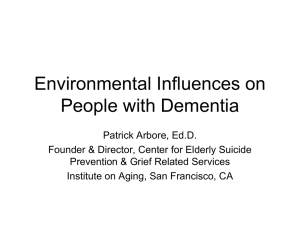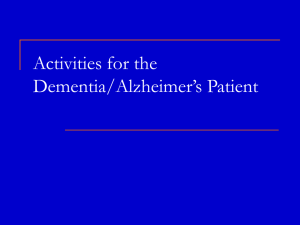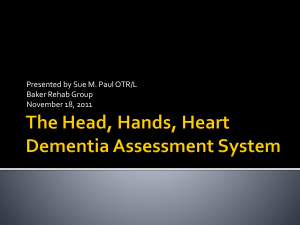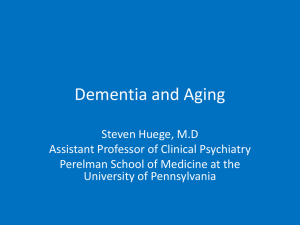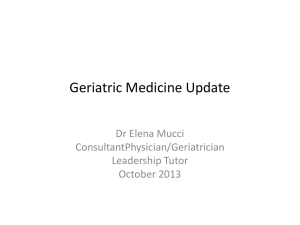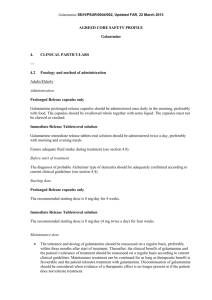601 Dementia - University Psychiatry
advertisement
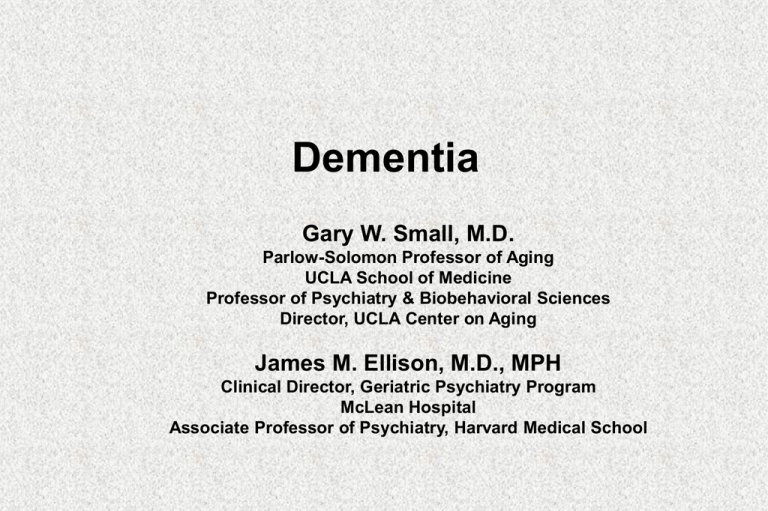
Dementia Gary W. Small, M.D. Parlow-Solomon Professor of Aging UCLA School of Medicine Professor of Psychiatry & Biobehavioral Sciences Director, UCLA Center on Aging James M. Ellison, M.D., MPH Clinical Director, Geriatric Psychiatry Program McLean Hospital Associate Professor of Psychiatry, Harvard Medical School Self-Assessment Question 1 Which of the following are required for a diagnosis of dementia? A. B. C. D. Cognitive decline is ACQUIRED MEMORY is affected In addition to memory, ANOTHER cognitive function is affected. Symptoms are not attributable to delirium or another psychiatric disorder. E. All of the above 2 Self-Assessment Question 2 Which of the following cognitive or behavioral domains is/are affected in dementia? A. B. C. D. E. Memory Executive function Behavior Activities of daily living All of the above 3 Self-Assessment Question 3 Which of the following statements is correct? A. Alzheimer’s Disease affects greater than 30% of adults older than 85 years of age. B. Alzheimer’s Disease is infrequent among adults less than 60 years of age. C. Alzheimer’s Disease is the most common cause of dementia. D. All of the above E. None of the above 4 Self-Assessment Question 4 Treatment of AD with cholinesterase inhibitors is based on which of these rationales? A. Noradrenergic neurotransmission in the locus ceruleus is reduced in late AD B. Pathological stimulation of NMDA receptors is associated with excitotoxic death of neurons. C. The number of cholinergic neurons in the basal forebrain is reduced in late Alzheimer’s disease. D. All of the above E. None of the above 5 Self-Assessment Question 5 Treatment of AD with memantine is based on which of these rationales? A. Noradrenergic neurotransmission in the locus ceruleus is reduced in late AD B. Pathological stimulation of NMDA receptors is associated with excitotoxic death of neurons. C. The number of cholinergic neurons in the basal forebrain is reduced in late Alzheimer’s disease. D. All of the above E. None of the above 6 Major Points Dementia is underrecognized and undertreated in primary care and in mental health settings Dementia can be recognized and treated beneficially in primary care and mental health settings Both pharmacological and nonpharmacological interventions may benefit overall brain health and dementia course 7 Major Points (cont.) Neuroimaging with PET can show a pattern of regional glucose metabolism that improves early detection of Alzheimer’s disease with greater specificity Novel approaches to in vivo plaque and tangle imaging will be useful in monitoring potential disease-modifying agents 8 Definition of Dementia Acquired syndrome of decline in memory and at least 1 other cognitive function (e.g., language) sufficient to affect daily life, not explainable by delirium or other mental disorder. Modified from Small GW et al. JAMA. 1997;278:1363-1371 9 Causes of Dementia Symptoms Alzheimer’s disease Vascular disease Lewy Body Disease Parkinson’s Huntington’s Frontotemporal dementias Head Injury Metabolic/Nutritional B12/Folate Thiamine Thyroid Hepatic/Renal Medications Alcohol/Toxins Infectious HIV Syphilis Meningitis Depression NPH Neoplasms Autoimmune disorders 10 Diagnostic Criteria for Alzheimer’s Disease (1) Multiple cognitive deficits manifested by both of: Memory impairment One (or more) of the following cognitive disturbances: aphasia, apraxia, agnosia, disturbance in executive functioning Significant impairment in social or occupational functioning representing a significant decline from a previous level of functioning Gradual onset and progressive cognitive decline American Psychiatric Association. Diagnostic and Statistical Manual of Mental Disorders. 4th ed. 1994:142-143. 11 Diagnostic Criteria for Alzheimer’s Disease (2) Cognitive deficits are NOT due to any of the following: Other central nervous system conditions that cause progressive deficits in memory and cognition Systemic conditions known to cause dementia Substance-induced conditions Deficits do not occur exclusively during delirium Disturbance is not better accounted for by another Axis I disorder American Psychiatric Association. Diagnostic and Statistical Manual of Mental Disorders. 4th ed. 1994:142-143. 12 Prevalence (%) Prevalence of Alzheimer’s Disease in the U.S. 40 32% 30 20 16% 10 0 1% 60-65 2% 65-70 8% 4% 70-75 75-80 80-85 >85 Age (Year) >65 years: 10% >85 years: 32-47% 68% are women Today: ~4 million have AD 2050: >14 million will have AD Clinical Neuroscience Research Associates (©CNRA, 2000) www.therubins.com. 13 Diagnosing AD: physical examination * Life-threatening conditions, e.g. mass lesions, vascular lesions and infections * Blood pressure and pulse * Vision and hearing assessments * Cardiac and respiratory function * Mobility and balance * Sensory and motor system examination (tone, reflexes, gait and coordination) and depressive symptoms (sleep and weight) Physical examination 14 Diagnosing AD: laboratory tests All patients Most patients * Complete blood count * Thyroid function * B12, folate, fasting homocysteine * BUN and creatinine * Calcium * Glucose * Electrolytes * Urinalysis * Liver function tests * Fasting lipid profile * ESR * ECG Many patients * Neuropsychological testing * Neuroimaging Some patients *Specialized medical labs *RPR *CXR *LP *ApoE genotype 15 Diagnosing AD: cognitive assessment with MMSE Cognitive area Mini Mental State Examination: test outline and scoring Score Maximum Score Actual Orientation *What is the (date, day, month, year, season)? * Where are you (clinic, town, country)? 5 5 Memory *Name three objects. Ask the patient to repeat them Attention *Serial sevens. Alternatively ask the patient to spell world backwards (dlrow) Cognitive Assessment 3 5 Folstein et al 197516 Diagnosing AD: cognitive assessment with MMSE (2) Cognitive area Mini Mental State Examination: test outline and scoring Score Maximum Score Actual Recall *Ask for the three objects mentioned above to be repeated 3 Language *Name a pencil and watch *Repeat, 'No ifs, ands or buts’ *A three stage command *Read and obey CLOSE YOUR EYES *Write a sentence *Copy a double pentagon 2 1 3 1 1 1 Total 30 Cognitive Assessment Folstein et al171975 Diagnosing AD: Neuropsychological Assessment1 • No current “gold standard” single test identified • Battery of tests improves sensitivity and specificity • Typical neuropsychological battery: • RAVLT or CAVLT • WAIS-R • WMS-R • Rey-Osterrieth Complex Figure • Clock drawing / Trails • Mattis Dementia Rating Scale • Predictive value of objective informant report is high 1. Petersen et al. 2001 and other sources 18 Diagnosing AD: Neuroimaging (Structural/Functional) AD Reproduced from Doraiswamy PM, 1998 19 Silverman et al. 2001 20 Amyloid Plaques and Neurofibrillary Tangles in Alzheimer’s Disease and Normal Aging Plaques Alzheimer’s Tangles Courtesy of Harry Vinters, M.D. Normal AAMI vs. MCI AAMI: defined vs younger controls; mild impairment, 1%/yr progress to dementia MCI: memory complaint, objective memory impairment on neuropsychological testing, often corroborated by observer. Called “amnestic” when only memory affected, “other” when memory not affected, subclassified as “single domain” vs “multiple domain”. Estimated 10-15%/yr progress to dementia. 22 Risk/Protective Factors for Brain Aging Definite risks Age Family history ApoEε4 genotype Other specific genotypes Probable/Possible risks Head trauma Diabetes Hypertension Lower educational achievement Chronic stress Possible protections Low-fat diet Aerobic exercise Cognitive stimulation Wine Antioxidants Anti-inflammatory drugs 23 The Progress of Alzheimer’s Disease Early Diagnosis 30 Mild-Moderate Severe Cognitive Symptoms 25 MMSE 20 Loss of ADLs 15 Behavioral Problems 10 NH Placement 5 Death 0 0 0.5 1.0 1.5 2.0 2.5 3.0 3.5 4.0 4.5 5.0 5.5 6.0 6.5 7.0 7.5 8.0 8.5 9.0 Gauthier, 1996 Years 5 Year Cost of Care Models for Mild, Moderate, and Severe Alzheimer’s Disease (as of 2000) $90,000 $75,000 Neumann et al., 1999 Kinosian et al., 2000 O'Brien et al., 1999 $60,000 $45,000 $30,000 $15,000 $0 Mild Moderate Severity of Alzheimer's Disease Severe * 10 year average costs may be as high as $109,000 for women and $67,000 for men. Kinosian, et al., 2000, Journal of the American Geriatrics Society 25 Delaying Onset Reduces Prevalence/Costs Cognitive Function Early Treatment No Treatment Time 26 Current Challenges in Dementia Diagnosis Primary care physicians (PCPs) PCPs care for most dementia patients (64%) Barrett et al, 1997 found that only 40% of PCPs knew Alzheimer’s was most common cause of late-life memory loss (vs. 97% of experts) PCPs usually do not use standardized dementia diagnostic criteria Missed diagnosis* >75% of patients with moderate dementia 97% of patients with mild dementia Underrecognition of dementia leads to increased: Motor vehicle accidents ER visits Hospitalization rates Medication errors Mortality *Callahan et al, 1995 When to Refer Geriatric Psychiatrist Unclear dx, early onset, severe behavior/mood problem, non-responsive to tx, unable to tolerate drugs, caregiver stress Neurologist Parkinson sx, early onset, focal neurological signs, rapid progression, atypical presentation Geriatrician Complex medical problems, functional assessment 28 When to Hospitalize Imminent danger to self or others Severe mood problems, agitation, psychosis Refusal to eat, severe sleep disturbance Psychiatric illness complicated by alcohol/drug addiction Need for drugs or tests requiring hospitalization Need for IV or frequent IM injections 29 Cholinergic System Innervates Areas Associated with Memory and Learning PC FC S OC B FC = Frontal cortex PC = Parietal cortex OC = Occipital cortex H = Hippocampus B = Nucleus basalis S = Medial septal nucleus Adapted from: Coyle JT et al. Science. 1983;219:1184-1190 H Rationale for Cholinergic Treatments of AD Cholinergic function including choline acetyltransferase (CAT) activity is reduced with aging1 Number of cholinergic neurons (particularly in basal forebrain) is reduced in late AD2 In AD, nicotinic receptors in hippocampus and cortex are reduced1,3 1Bartus RT et al. Science. 1982;217:408-414; 2Whitehouse PJ et al. Science. 1982;215:1237-1239; 3Guan ZZ et al. J Neurochem. 2000;74:237-243 (from Small G: Dementia. ACNP Curriculum) 31 Cholinesterase Inhibitor Properties Selectivity Max serum conc Absorbtion delay by food? Serum Half-Life (hr) Protein Binding % Target Dose (mg/day) Daily Dosing Tacrine (Cognex) AChE &BuChE 1-2 hr Yes 1.3-2 75 80-160 qid Donepezil (Aricept) AChE 3-5 hr No 70-80 96 5-10 qd Rivastigmine (Exelon) AChE &BuChE 0.5-2 hr Yes 2 40 6-12 bid Galantamine (Razadyne or Razadyne ER) AChE & Nic Mod 30-60 min 5-7 ER is longer 10-20 16-24 bid or qd Yes 32 Most Frequent Adverse Effects of Cholinesterase Inhibitors* Nausea 13% to 35% Anorexia 5% to 14% Dizziness 1% to 10% Diarrhea 0% to 11% Cost ~$150/mo. *These numbers are taken from package inserts for ChI’s. 33 Mean Change from Baseline Effect of Donepezil on Cognition: ADAS-Cog* -3 † -2 * † † Clinical Improvement -1 ‡ 0 ¥ † Clinical Decline 1 2 3 4 Baseline 10 mg/day (N=157) 5 mg/day (N=154) Placebo (N=162) 6 12 18 Weeks on Therapy Endpoint 30 Placebo Washout *Alzheimer’s Disease Assessment Scale-Cognitive Subscale. †p<0.0001; ‡p<0.0007; ¥p<0.0012 Rogers SL et al. Neurology. 1998;50:136-145 Mean (± SE) Change from Baseline in ADAS-cog Score Effect of Galantamine on Cognition: ADAS-Cog* Double-Blind -4 -3 -2 -1 0 1 2 3 4 5 6 7 Open-Extension Improvement † 0 3 6 9 12 Deterioration Months Placebo/Galantamine 24 mg (N=213/135) Historical placebo group Galantamine 24 mg/Galantamine 24 mg (N=212/116) *ADAS-Cog = Alzheimer’s Disease Assessment Scale-Cognitive Subscale; †p<0.05 vs. placebo/ Galantamine and not statistically different from baseline; Raskind MA et al. Neurology. 2000;54:2261-2268 Mean Change from Baseline Efficacy of Rivastigmine on Cognition Through 52 Weeks: ADAS-Cog* All Patients Taking Rivastigmine 2-12 mg/day Improve † Baseline -1 0 1 2 3 4 5 6 7 8 † † † † 6-12 mg/day 1-4 mg/day Placebo Projected placebo (N=196) 0 26 † † † † Decline 38 44 52 Weeks *Alzheimer’s Disease Assessment Scale–Cognitive Subscale; †p<0.05 vs. projected placebo; Corey-Bloom J et al. Int J Geriatr Psychopharmacol. 1998;1:55-65; Adapted from: Messina J et al. The 3rd Int’l Meeting for the College of Psychiatric and Neurologic Pharmacists. April 6-9, 2000. Washington, DC; Novartis Pharmaceuticals Corporation (Data on file) Long-Term Effects of Donepezil on Cognition: ADAS-Cog* Mean Change from Baseline -6 Improvement 0 Decline 6 12 Decline in ADAS-cog score based on the natural history of untreated patients with moderate Alzheimer’s disease† 18 0 6 12 14 26 38 50 62 74 85 98 Cumulative Weeks from Baseline of the Double-Blind Study *Alzheimer’s Disease Assessment Scale-Cognitive Subscale; Rogers SL, Friedhoff LT. Eur Neuropsychopharmacol. 1998;8:67-75; †Stern RG et al. Am J Psychiatry. 1994;151:390396 Mean (± SE) Change from Baseline in NPI Effect of Galantamine on Behavioral Symptoms: NPI Dose increments -3 -2 -1 0 1 Improvement * 2 3 4 5 6 † Placebo Galantamine 16 mg/day Galantamine 24 mg/day 0 1 2 3 Months 4 5 Deterioration *p<0.05 vs. placebo (galantamine 16 mg and 24 mg); †p<0.05 vs. baseline; Adapted from: Tariot PN et al. Neurology. 2000;54:2269-2276 Change in Daily Time Spent by Caregiver Assisting with ADL Change from Baseline in Daily Time Spent Assisting with ADL (Min) 30 20 10 Galantamine 24 mg/day (N=165) * Placebo (N=160) 0 -10 -20 -30 -40 -50 *p<0.05 vs. baseline; Lilienfeld S, Parys W. Dement Geriatric Cog Disord. 2000;11(suppl 1):19-27; Wilcock G et al. World Alzheimer Congress, 2000 Donepezil and Concomitant Treatments Percentage of Caregivers Reporting Patient’s Drug Use, by Category Drug Category Antidepressant Antipsychotic Antianxiety Estrogen Antiparkinsonian Sedative-hypnotic Donepezil (%) (N=108) Nondonepezil (%) (N=268) 25 19 13 10 5 2 43* 34* 22† 8 7 6† *Pearson chi-square test, p<0.05; †Pearson chi-square test, p<0.10; Small GW et al. Clin Ther. 1998;20:838-850 Galantamine in the Study of Alzheimer’s Disease, Vascular Dementia or Mixed Dementia Mean ( SE) Change in ADAS-Cog from Baseline ADAS-Cog Change -3 * -2 * * Improvement * -1 0 1 2 Placebo/galantamine Galantamine/galantamine Double-Blind Phase Baseline Week 6 Month 3 Month 6 Open-Label Phase Deterioration Month 12 *p<0.001 vs. placebo; Erkinjuntti T et al. Lancet. 2002;359:1283-1290; Janssen Pharmaceutica Products, L.P. (Data on file) AD2000 Study (UK) Randomized Clinical Trial of Donepezil / Placebo in 566 AD patients followed for up to 4 years Cognition (MMSE) and ADLs improved by donepezil over the first 2 years No significant benefits in risk of institutionalization or progression of disability Conclusion: “Donepezil is not cost effective, with benefits below minimally relevant thresholds.” 42 Lancet 2004;363:2105-15 AD2000 Study - Limitations •Underpowered: 566 / 3,000 subjects enrolled •High attrition: 48% after 1 year, >80% after 2 years •Lack of rigorous diagnostic criteria •Repeated drug wash-out periods 43 Lancet 2004;363:2105-15 Pharmacology of Memantine Aminoadamantane derivative (1-amino-3,5-dimethyladamantane) NMDA receptor uncompetitive (open channel) antagonist – low/moderate affinity 5-HT3 receptor allosteric antagonist of low/moderate affinity Binds with lower affinity to human nicotinic acetylcholine receptors – but may not be clinically relevant (does not alter AChE activity in the presence or absence of AChEIs) 44 Memantine: Clinical Pharmacokinetics 100% oral bioavailability Crosses blood-brain barrier rapidly No effects of food, age and gender Linear, dose-proportional kinetics (range 5- 40 mg) Elimination half-life of 60 - 80 hours Basis for dosing recommendation: BID dosing better tolerated than QD dosing in early trials Up-titration improves tolerability Metabolism: Eliminated mostly in urine as parent drug and inactive metabolites Lower dose recommended in moderate renal disease. No or minimal effects on P450 isoenzymes No PK/PD interactions with donepezil 45 p < 0.001 Mean (SEM) Change From Baseline 2.0 0.0 -2.0 p < 0.001 p = 0.002 -4.0 Improvement p = 0.068 Worsening Memantine Improves Cognitive Function in Alzheimer’s Disease -6.0 6pt -8.0 Memantine -10.0 Placebo Treatment Week -12.0 0 n= n= 126 126 4 119 117 12 107 106 Reisberg et al. NEJM 2003;348:1333-1341 28 96 83 End Point 126 126 46 3.0 p = 0.006 p = 0.057 p < 0.001 2.0 p < 0.001 1.0 0.0 3pt -1.0 Memantine/donepezil -2.0 Placebo/donepezil -3.0 Improvement p = 0.030 Worsening Mean (SEM) Change From Baseline 4.0 Memantine Added to Donepezil in AD Confers Additional Cognitive Benefits p < 0.001 Treatment Week -4.0 0 n= n= 198 197 4 197 194 8 190 180 12 185 169 Tariot et al. JAMA 2004;291:317-24 18 181 164 24 171 153 End Point 198 196 47 Adverse Events* (Reported by ≥ 5% of Patients in Either Treatment Group) Double-Blind, Placebo-Controlled Dementia Trials Placebo (N = 922) n (%) Memantine (N = 940) n (%) 624 (67.7) 662 (70.4) Dizziness 49 (5.3) 64 (6.8) Agitation 98 (10.6) 63 (6.7) Confusion 42 (4.6) 58 (6.2) Headache 31 (3.4) 54 (5.7) Constipation 28 (3.0) 50 (5.3) Fall 50 (5.4) 48 (5.1) Inflicted Injury 64 (6.9) 44 (4.7) Any adverse event Lack of significant effect on vital signs, tested lab parameters, ECG * Adverse events were considered treatment emergent if not present at baseline or if present at baseline and increased in severity during the treatment period. 48 Promising AD Therapies in Current Development (1) Agent Mechanism: AChEI Status Huperzine A AcChE inhibitor and other effects II Agent Mechanism: Immunotherapy Status ACC 001 Aβ fragment/carrier to induce Ab against Aβ Anti-Aβ monoclonal antibodies Anti-Aβ antibodies Humanized monoclonal antibody to Aβ I Bapineuzumab LY 2062430 RN 1219 II II I 49 Promising AD Therapies in Current Development (2) Agent Mechanism: Amyloid-Lowering Agents Status MPC 7869 (Flurizan) Selective amyloid-lowering agent III LY 450139 Inhibits β amyloid synthesis/ secretase activity II -secretase inhibitor MK 0752 Posiphen III β amyloid synthesis and β secretase activity inhibitor I Binds to Aβ peptide, maintains non-fibrillar form Tramiprosate (Alzhemed) III 50 For Reference: Additional Alzheimer’s Disease Treatments Under Investigation (1) Agent Mechanism CX 516 CX 717 DHA EGb 761 FK 962 GABA Aagonists GTS 21 Immune globulin Lecozotan AMPA receptor modulator AMPA receptor modulator Omega 3 FFA Improves blood flow, multiple effects 5HT agonist GABA A receptor agonists Synthetic nicotinic agonist Immune globulin Selective 5HT1A antagonist 51 Source (in part): http://newmeds.phrma.org, 2007 For Reference: Additional Alzheimer’s Disease Treatments Under Investigation (2) Agent Mechanism ABT 089 AC 1202 AL108 Alfatradiol Atorvastatin C 7617 C 9136 CERE 110 Conjugated estrogens nAChR modulator Lowers oxidative stress Neuroprotective peptide (intranasal) 17-alpha-Estradiol Statin Neuroprotectant Neuroprotectant NGF agonist Estrogens 52 Source (in part): http://newmeds.phrma.org, 2007 For Reference: Additional Alzheimer’s Disease Treatments Under Investigation (3) Agent Mechanism Leuprorelin Levacecarnine GnRH analogue (acetyl-L-carnitine) Neuroprotective, unclear mechanism AMPA receptor agonist Ca channel modulator PDE4 inhibitor Glucocorticoid antagonist ? LY 451395 MEM 1003 MEM 1414 Mifepristone MK 0249 53 Source (in part): http://newmeds.phrma.org, 2007 For Reference: Additional Alzheimer’s Disease Treatments Under Investigation (4) Agent Mechanism MK 0952 Modafinil Neramexane NGX 267 Nicergoline PAZ 417 PF 3084014 Phenserine PRX 03140 PRX 07034 PDE4 inhibitor Mechanism unclear NMDA receptor antagonist Muscarinic M1 agonist Alpha adrenergic vasodilator ? ? Inhibits AChE and β amyloid synthesis 5HT4 agonist Selective 5-HT6 receptor antagonist 54 Source (in part): http://newmeds.phrma.org, 2007 For Reference: Additional Alzheimer’s Disease Treatments Under Investigation (5) Agent Mechanism R 1500 R-phenserine Rasagiline RN 1219 Rosiglitazone Selegiline transdermal SGS 742 SIB 1553A T817MA ? ? Selective MAO B inhibitor Humanized monoclonal antibody to Aβ PPAR agonist Selective irrev. MAO B inhibitor GABA B antagonist nAChR agonist Neurotrophic agent 55 Source (in part): http://newmeds.phrma.org, 2007 For Reference: Additional Alzheimer’s Disease Treatments Under Investigation (6) Agent Mechanism Triacetyluridine TTP 488 Uridine precursor (pro-drug) Decreases formation, deposition and accumulation of amyloid plaque 5HT 1a agonist and NGF agonist Xaliproden 56 Source (in part): http://newmeds.phrma.org, 2007 Acute Nonpharmacologic Approaches to Treating Noncognitive Behavioral Symptoms in Demented Patients Assure safety/adequate supervision Attend to environmental factors Educate support system Redirect and arrange pleasant experiences Do not rely on learning/memory Physical restraint is rarely necessary 57 Psychosocial Treatments for NCBS • Psychoeducation for caregivers • Individual behavioral plan for pt/caregiver • Cognitive stimulation • Music therapy • Snoezelen • Sensory stimulation • • • • • • Reminiscence therapy Validation therapy Reality orientation therapy Montessori activities Physical exercise Enforced social interaction Evidence for benefit Evidence for acute benefit only Minimal evidence for benefit 58 Livingston et al. Am J Psychiatry 2005;162:1996-2021 Current Controversies over Pharmacotherapy of Behavioral and Psychological Symptoms of Dementia Use of Vitamin E: Still recommended? Use of antipsychotics for behavioral symptoms: CVAE / Increased total mortality Black box warnings Shortcomings of data Anticonvulsants Antidepressants Cholinesterase inhibitors/ Memantine 59 Additional Material on Early Detection of Alzheimer’s Disease 60 Neuropathological Studies of Nondemented Elderly Morris et al1 Cerebral amyloid deposition in 21 elderly men, followed longitudinally 78% with high cortical plaque density had MCI Few or no plaques = cognitively intact Braak & Braak2 Neurofibrillary tangles appear to accumulate and extend from the entorhinal cortex as early as the third decade 1 Neurology. 1996;46:707-719; 2Acta Neuropathol. 1991;82:239-259 Developing Tools for Early Detection of Alzheimer’s Disease Amyloid Imaging Cognitive Function FDG-PET Genetic Risk Cognitive Stress Test Onset Current Clinical Approach Presymptomatic Stages AD Time Genetic Risk Apolipoprotein E (APOE)—gene on chromosome 19 APOE-4 in 20% of population APOE-4 increases risk, lowers onset age for AD APOE-4 may have modest effect in predicting cognitive decline in older persons, but APOE alone not considered a useful predictive test 63 Cognitive Stress Test with fMRI Functional brain measures during memory performance may uncover subtle brain dysfunction not observed during mental rest (cf. treadmill ECG for cardiac disease) Combine neuroimaging and APOE-4 measures of genetic risk in order to identify abnormalities that may predict future cognitive decline Bookheimer SY, Strojwas MH, Cohen MS, et al. N Engl J Med. 2000 64 Increase Brain Activity During Memory Tasks E-4 E-3 Bookheimer SY, Strojwas MH, Cohen MS, et al. N Engl J Med. 2000 Positron Emission Tomography (PET) Cerebral Metabolism in Alzheimer’s Disease Progression and in Normal Brains Normal Early Alzheimer’s Courtesy of Gary W. Small, M.D., UCLA Late Alzheimer’s Child Accuracy of Early Diagnostic Assessment: Standard Clinical vs. FDG-PET Multiple clinical assessments over years in 134 patients Diagnostic accuracy1 Sensitivity: 83-85% Specificity: 50-55% Single baseline PET scan in 284 patients (138 autopsy diagnosis) Diagnostic accuracy2 Sensitivity: 93-95% Specificity: 73-78% 1Lim 2127 et al. J Am Geriatric Soc. 1999;47:564-569; 2Silverman et al. JAMA. 2001;286:2120- Case Example 65-year-old woman diagnosed with depression and attention deficit after 2 1/2 years of multiple neuropsychiatric evaluations including serial MRI scans PET showed typical Alzheimer’s pattern Symptoms improved with cholinergic treatment FDG-PET shows parietal deficit Silverman & Small, 2002. Am J Psychiatry. 2002;159:1482-1488 68 Practical Consequences of Improved Diagnostic Accuracy Accurate diagnostic information and education reduces family/caregiver burden Decreased likelihood of repeated diagnostic assessments and testing “Alzheimer’s disease label” improves caregiver attitudes1 Information about the disease improves quality of life for family/patient and delays nursing home placement2 1Wadley et al. J Gerontol. 2001;56:244-252; 2Mittelman et al. JAMA. 1996;276:1725-1731 Practical Consequences of Improved Diagnostic Accuracy (Cont.) Early, accurate diagnosis and treatment ... Maintains patients at higher levels of functioning leading to fewer MD/hospital visits1 Reduces caregiver burden2 Delays nursing home placement3 Reduces use of other psychotropic drugs4 1Small et al. J Am Geriatr Soc. 2002;50:321-327; 2Shikier et al. J Am Geriatr Soc. 2000;48:268-274; 3Knopman et al. Neurology. 1996;47:166-177; 4Small et al. Clin Therapeutics. 1998;20:838-850 Pet and Genetic Risk for Alzheimer Disease Normal Memory Dementia PET Imaging -18% Genetic Risk No APOE-4 -12% -20% -22% APOE-4 Lower inferior parietal metabolism in nondemented persons with a single copy of APOE-4 Small et al. PNAS. 2000;97:6037-6042 PET Scans Show Brain Function Decline in People at Genetic Risk for Alzheimer’s Disease Small et al. PNAS. 2000;97:6037-6042 Number of Subjects Per Treatment Group Needed to Detect a Drug Effect in 2 Years Using PET* Number of Subjects 300 250 APOE-4 carriers APOE-4 noncarriers 200 150 100 50 0 0.5 0.33 0.25 Estimated Drug Treatment Effect *Posterior cingulate metabolism; Based on data from: Reiman et al. PNAS. 2001;98:3334-3339 Metabolic Function Possible Outcomes Using PET as a Surrogate Marker in AAMI Clinical Trials APOE 3/4 and Active Drug Baseline APOE 3/4 and Placebo Follow-Up Time AAMI = age-associated memory impairment Early Detection and Intervention 1o outcome: PET + APOE-4 Cognitive Function 1. Celecoxib 2. Donepezil 1o outcome: clinical exam 1. 2. 3. 4. 5. Donepezil vs. vitamin E Donepezil vs. ginkgo Donepezil vs. estrogen Rivastigmine Galantamine AAMI MCI AD Time Shoghi-Jadid, et al. Am J Geriatr Psychiatry. 2002;10:24-35 UCLA School of Medicine Slowing Down Brain Aging Minimize stress Mental aerobics Physical exercise Healthy brain diet Lifestyle choices Medicines Memory training skills 77 Small. BMJ. 2002; 324:1502-5 Major Points Dementia is underrecognized and undertreated in primary care and in mental health settings Dementia can be recognized and treated beneficially in primary care and mental health settings Neuroimaging with PET can show a pattern of regional glucose metabolism that improves early detection of Alzheimer’s disease with greater specificity Major Points (cont.) Both pharmacological and nonpharmacological interventions may benefit overall brain health and dementia course Novel approaches to in vivo plaque and tangle imaging will be useful in monitoring potential disease-modifying agents Major Points Dementia is underrecognized and undertreated in primary care and in mental health settings Dementia can be recognized and treated beneficially in primary care and mental health settings Both pharmacological and nonpharmacological interventions may benefit overall brain health and dementia course 80 Major Points (cont.) Neuroimaging with PET can show a pattern of regional glucose metabolism that improves early detection of Alzheimer’s disease with greater specificity Novel approaches to in vivo plaque and tangle imaging will be useful in monitoring potential disease-modifying agents 81 Suggested Readings Cummings JL. Alzheimer's disease: from molecular biology to neuropsychiatry. Seminars in Clinical Neuropsychiatry. 8:31-6, 2003 Cummings JL. Cole G. Alzheimer disease. JAMA. 287:2335-8, 2002 Small GW. Rabins PV. Barry PP. et al. Diagnosis and treatment of Alzheimer disease and related disorders. Consensus statement of the American Association for Geriatric Psychiatry, the Alzheimer's Association, and the American Geriatrics Society. JAMA. 278:1363-71, 1997 Small GW. What we need to know about age related memory loss. Br Med J 2002;324:1502-5. 82 Self-Assessment Question 1 Which of the following are required for a diagnosis of dementia? A. B. C. D. Cognitive decline is ACQUIRED MEMORY is affected In addition to memory, ANOTHER cognitive function is affected. Symptoms are not attributable to delirium or another psychiatric disorder. E. All of the above 83 Self-Assessment Question 2 Which of the following cognitive or behavioral domains is affected in dementia? A. B. C. D. E. Memory Executive function Behavior Activities of daily living All of the above 84 Self-Assessment Question 3 Which of the following statements is correct? A. Alzheimer’s Disease affects greater than 30% of adults older than 85 years of age. B. Alzheimer’s Disease is infrequent among adults less than 60 years of age. C. Alzheimer’s Disease is the most common cause of dementia. D. All of the above E. None of the above 85 Self-Assessment Question 4 Treatment of AD with cholinesterase inhibitors is based on which of these rationales? A. Noradrenergic neurotransmission in the locus ceruleus is reduced in late AD B. Pathological stimulation of NMDA receptors is associated with excitotoxic death of neurons. C. The number of cholinergic neurons in the basal forebrain is reduced in late Alzheimer’s disease. D. All of the above E. None of the above 86 Self-Assessment Question 5 Treatment of AD with memantine is based on which of these rationales? A. Noradrenergic neurotransmission in the locus ceruleus is reduced in late AD B. Pathological stimulation of NMDA receptors is associated with excitotoxic death of neurons. C. The number of cholinergic neurons in the basal forebrain is reduced in late Alzheimer’s disease. D. All of the above E. None of the above 87 Self-Assessment Question Answers 1. 2. 3. 4. 5. E E A C B 88


